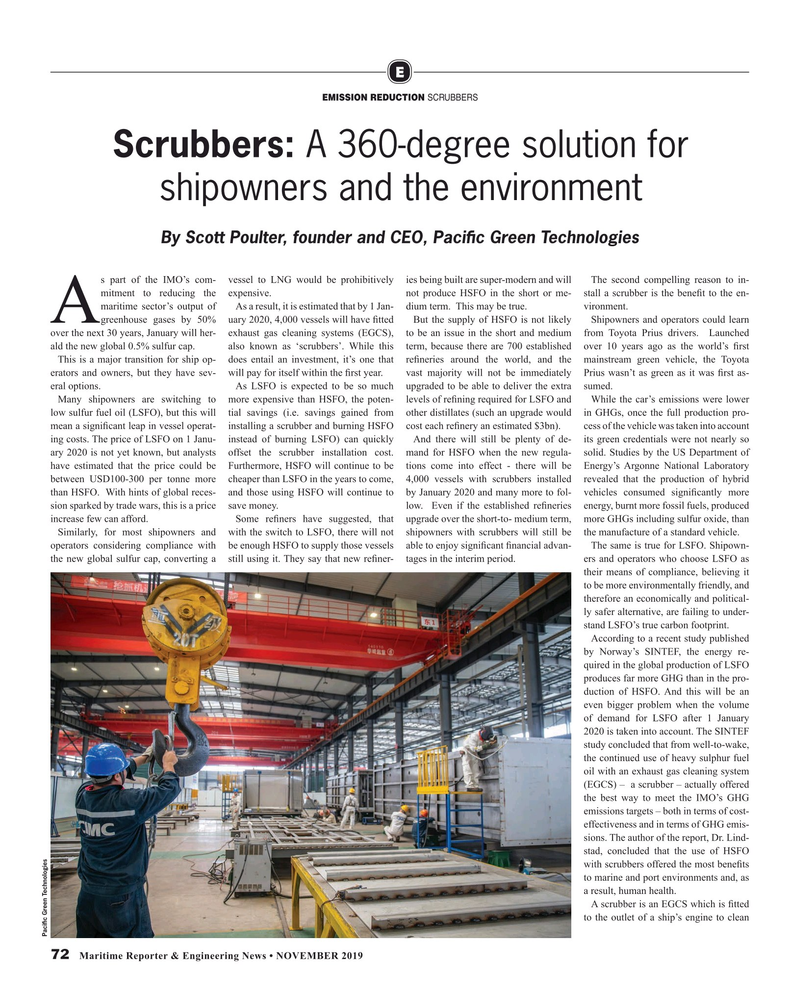
Page 72: of Maritime Reporter Magazine (November 2019)
Workboat Edition
Read this page in Pdf, Flash or Html5 edition of November 2019 Maritime Reporter Magazine
E
EMISSION REDUCTION SCRUBBERS
Scrubbers: A 360-degree solution for shipowners and the environment
By Scott Poulter, founder and CEO, Paci? c Green Technologies s part of the IMO’s com- vessel to LNG would be prohibitively ies being built are super-modern and will The second compelling reason to in- mitment to reducing the expensive. not produce HSFO in the short or me- stall a scrubber is the bene? t to the en- maritime sector’s output of As a result, it is estimated that by 1 Jan- dium term. This may be true. vironment.
Agreenhouse gases by 50% uary 2020, 4,000 vessels will have ? tted But the supply of HSFO is not likely Shipowners and operators could learn over the next 30 years, January will her- exhaust gas cleaning systems (EGCS), to be an issue in the short and medium from Toyota Prius drivers. Launched ald the new global 0.5% sulfur cap. also known as ‘scrubbers’. While this term, because there are 700 established over 10 years ago as the world’s ? rst
This is a major transition for ship op- does entail an investment, it’s one that re? neries around the world, and the mainstream green vehicle, the Toyota erators and owners, but they have sev- will pay for itself within the ? rst year. vast majority will not be immediately Prius wasn’t as green as it was ? rst as- eral options. As LSFO is expected to be so much upgraded to be able to deliver the extra sumed.
Many shipowners are switching to more expensive than HSFO, the poten- levels of re? ning required for LSFO and While the car’s emissions were lower low sulfur fuel oil (LSFO), but this will tial savings (i.e. savings gained from other distillates (such an upgrade would in GHGs, once the full production pro- mean a signi? cant leap in vessel operat- installing a scrubber and burning HSFO cost each re? nery an estimated $3bn). cess of the vehicle was taken into account ing costs. The price of LSFO on 1 Janu- instead of burning LSFO) can quickly And there will still be plenty of de- its green credentials were not nearly so ary 2020 is not yet known, but analysts offset the scrubber installation cost. mand for HSFO when the new regula- solid. Studies by the US Department of have estimated that the price could be Furthermore, HSFO will continue to be tions come into effect - there will be Energy’s Argonne National Laboratory between USD100-300 per tonne more cheaper than LSFO in the years to come, 4,000 vessels with scrubbers installed revealed that the production of hybrid than HSFO. With hints of global reces- and those using HSFO will continue to by January 2020 and many more to fol- vehicles consumed signi? cantly more sion sparked by trade wars, this is a price save money. low. Even if the established re? neries energy, burnt more fossil fuels, produced increase few can afford. Some re? ners have suggested, that upgrade over the short-to- medium term, more GHGs including sulfur oxide, than
Similarly, for most shipowners and with the switch to LSFO, there will not shipowners with scrubbers will still be the manufacture of a standard vehicle.
operators considering compliance with be enough HSFO to supply those vessels able to enjoy signi? cant ? nancial advan- The same is true for LSFO. Shipown- the new global sulfur cap, converting a still using it. They say that new re? ner- tages in the interim period. ers and operators who choose LSFO as their means of compliance, believing it to be more environmentally friendly, and therefore an economically and political- ly safer alternative, are failing to under- stand LSFO’s true carbon footprint.
According to a recent study published by Norway’s SINTEF, the energy re- quired in the global production of LSFO produces far more GHG than in the pro- duction of HSFO. And this will be an even bigger problem when the volume of demand for LSFO after 1 January 2020 is taken into account. The SINTEF study concluded that from well-to-wake, the continued use of heavy sulphur fuel oil with an exhaust gas cleaning system (EGCS) – a scrubber – actually offered the best way to meet the IMO’s GHG emissions targets – both in terms of cost- effectiveness and in terms of GHG emis- sions. The author of the report, Dr. Lind- stad, concluded that the use of HSFO with scrubbers offered the most bene? ts to marine and port environments and, as a result, human health.
A scrubber is an EGCS which is ? tted to the outlet of a ship’s engine to clean
Paci? c Green Technologies 72 Maritime Reporter & Engineering News • NOVEMBER 2019
MR #11 (66-73).indd 72 11/4/2019 10:43:43 AM

 71
71

 73
73
